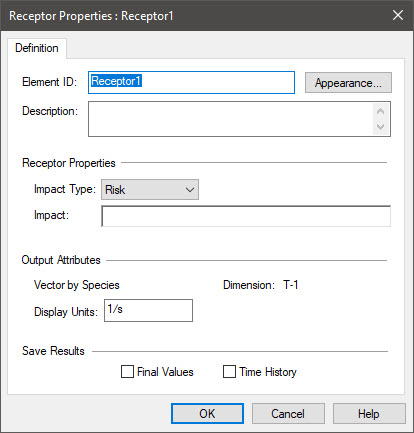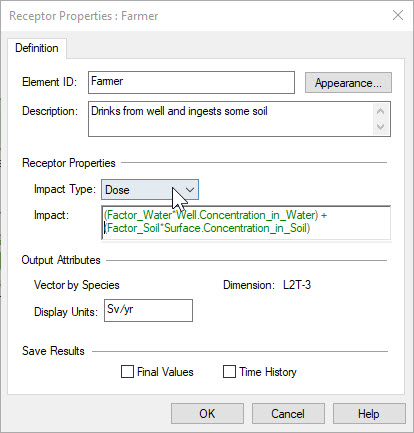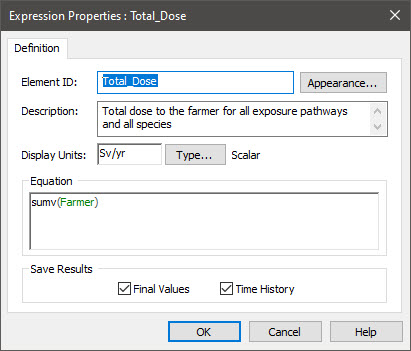Courses: The GoldSim Contaminant Transport Module:
Unit 10 - Using Features of the RT Module: Modeling Decay Chains, Isotopes and Doses
Lesson 8 – Modeling Impacts Using the Receptor Element
In almost all models in which you are modeling radionuclides, you are not necessarily interested in the concentration of species at a particular point, but are instead interested in the impact of these species on specific receptors (typically humans, but also wildlife).
The impact to a receptor (e.g., a farmer) from being exposed to contaminants via a particular exposure pathway (e.g., ingesting contaminated water, ingesting contaminated soil or food) is typically computed by multiplying contaminant concentrations in an environmental medium (e.g., water, soil) to which the receptor is exposed by what we will refer to in this discussion as pathway impact conversion factors.
Impacts are quantified either as 1) an incremental cancer risk per individual per unit time, 2) a radiation dose per unit time, or 3) a Hazard Index (the concentration in a medium divided by a reference concentration). For radionuclides, the impact of interest will generally be a dose (although it could also be an incremental cancer risk). When the impact is a dose, the pathway impact conversion factor referenced above is sometimes referred to as a pathway dose conversion factor.
Pathway impact conversion factors for a particular exposure pathway and receptor are species-specific and have dimensions of impact per unit concentration in a particular medium. Hence, they are a vector of species. Concentrations in a particular medium are also a vector of species. So the impact for a particular exposure pathway (e.g., ingestion of groundwater) is a vector of species that can be computed by carrying out a term-by-term multiplication of two vectors using the multiplication (*) operator:
Impact = Concentration_Vector * Impact_Conversion_Factor_Vector
Note: Once you have an impact vector, you could compute a total impact (summed over all species) by using the Sumv array function. The Sumv function sums the components of a vector (producing a scalar).
The actual impact to a receptor is computed as the sum of the impacts associated with each exposure pathway (e.g., drinking water from a well, breathing dust in the atmosphere, ingesting soil). That is, typically, the impact to a receptor will be a sum of several term-by-term vector multiplications, since the receptor is likely to interact with multiple contaminated media (e.g., water in a well, soil, dust).
All of these calculations, of course, could be carried out using an Expression element. However, for convenience, GoldSim provides a specialized version of an Expression element called a Receptor to facilitate this calculation.
The dialog for a Receptor is shown below:

The dialog has three inputs:
The first is the Impact type. This is the type of impact to be computed. GoldSim provides three options:
- Risk (e.g., health or cancer risk);
- Dose (radioactive dose); and
- Hazard Index.
The choice of the Impact type determines the dimensions of the Receptor output (and therefore the dimensions of the vector accepted by the Impact input field):
- A Risk has dimensions of inverse time (e.g., the incremental cancer risk per individual per year);
- A Dose has dimensions of radiation dose per time (e.g., mrem/yr, Sv/yr);
- A Hazard Index is dimensionless and is intended to represent a ratio of concentrations (the concentration in a medium divided by some reference concentration).
After defining the Impact Type, you define the Impact. This is the equation describing the impact itself. It must be a vector by species. Its dimensions are determined by the impact type.
For Risk and Dose impacts, it will typically be specified as a sum of several term-by-term vector multiplications (a concentration vector multiplied by a pathway impact conversion factor vector).
For a Hazard Index impact, it will typically be specified as a single term-by-term vector division (a ratio of concentrations).
Finally, you define the Display Units. This selects the units in which the output of the Receptor is displayed. The acceptable dimensions are determined by the Impact Type (inverse time for Risk, dose/time for Dose, dimensionless for Hazard Index).
Essentially, a Receptor element is simply a specialized Expression element in which:
- the key input (Impact) and the output is always a vector of species; and
- the correct dimensions (as defined by the specified Display Units) are defined by the specified Impact Type.
Note: Although the Receptor element is most often used when using the RT Module, it is also available in the CT Module.
Considering the computed impact for a single exposure pathway, as pointed out above, the Impact should be an equation that multiplies a vector of concentrations by a vector of pathway impact conversion factors. The nature of these conversion factors is a function of the Impact Type:
- For a Dose, the vector of conversion factors will have units of dose rate per unit concentration, such as (mSv/yr) / (g/m3).
- For a Risk, the vector of conversion factors will have units of incremental risk per unit time per unit concentration, such as (1/yr) / (g/m3).
- For a Hazard Index, the vector of conversion factors would have units of inverse concentration (the reference concentration), such as (m3/g).
To illustrate in general how the Impact equation is written, let’s discuss a very simple example in which we wish to compute a dose to a Receptor (e.g., a farmer) who has two exposure pathways: drinking contaminated water, and ingesting contaminated soil. In such a case, the model would of course contain some pathways that computed these concenatrations. Let’s assume the water concentration (a vector of species) is Well.Concentration_in_Water and the soil concentration is Surface.Concentration_in_Soil.
For the water exposure pathway, we would define a pathway impact conversion factor as follows:
Factor_Water = Water_Ingestion_DCF * Species.Specific_Activity * Water_Ingestion_Rate
In this equation:
- Water_Ingestion_DCF is a vector of species (dose conversion factors that vary by species). It has dimensions of dose/activity (e.g., Sv/Bq).
- Species.Specific_Activity is a vector of species (specific activities). It is an output of the Species element (you don’t need to create it). It has dimensions of activity/mass (e.g., Bq/g).
- Water_Ingestion_Rate is a scalar that specifies the rate of water ingestion by the Receptor. It has dimensions of volume/time (e.g., m3/yr).
If you multiply these together, you will see that the resulting vector has dimensions of dose rate/concentration, such as (Sv/yr)/(g/m3). Multiplying this by the water concentration (e.g., in g/m3) produces a vector with dimensions of a dose rate (e.g., Sv/yr).
For the soil exposure pathway, we would define a pathway impact conversion factor as follows:
Factor_Soil = Soil_Ingestion_DCF * Species.Specific_Activity * Soil_Ingestion_Rate
In this equation:
- Soil_Ingestion_DCF is a vector of species (dose conversion factors that vary by species). It has dimensions of dose/activity (e.g., Sv/Bq).
- Species.Specific_Activity is a vector of species (specific activities). It is an output of the Species element (you don’t need to create it). It has dimensions of activity/mass (e.g., Bq/g).
- Soil_Ingestion_Rate is a scalar that specifies the rate of soil ingestion by the Receptor. It has dimensions of mass/time (e.g., kg/yr).
If you multiply these together, you will see that the resulting vector has dimensions of dose rate/concentration, such as (Sv/yr)/(g/kg). Multiplying this by the soil concentration (e.g., in g/kg) produces a vector with dimensions of a dose rate (e.g., Sv/yr).
The Total Dose (from both exposure pathways) would be computed as follows:
Total_Dose = (Factor_Water * Well.Concentration_in_Water) + (Factor_Soil * Surface.Concentration_in_Soil)
This is what the Receptor element would look like in this case:

So it is clear here that the Receptor is simply a specialized version of the Expression element. You could have accomplished the same thing in an Expression, but the Receptor simply makes the calculation a bit easier.
Note that you could create two separate calculations in this case (two Receptor elements), so that the dose from water ingestion may be compared to that from soil ingestion. This is useful in determining which exposure pathway (and which species) contributes more to the overall dose.
As noted previously, if you wanted to compute a total dose (summed over all species) you would create an Expression that looked like this:

Several points should be noted regarding this simple example:
- This simple example includes two exposure pathways (drinking water and ingesting soil). More realistic models would likely include a large number of exposure pathways, including ingestion of various foods, inhalation of particulates or volatile species, and direct exposure to radiation (as opposed to ingestion).
- For all of these exposure pathways we ultimately need a concentration of the species in some medium (e.g., water, soil, air, vegetable, milk, meat). In some cases (e.g., food) the GoldSim model will likely not be computing the concentration in various types of food directly. Rather, that concentration will be computed (using some conversion factors) based on the concentration in enviromental media such as water and soil.
- When defining the dose conversion factors mentioned above, it is important to account for contributions to dose from the “skipped” radionuclides.
The manner of addressing these kinds of issues is beyond the scope of this Course, but is well-known to health physicists and risk assessment professionals.
